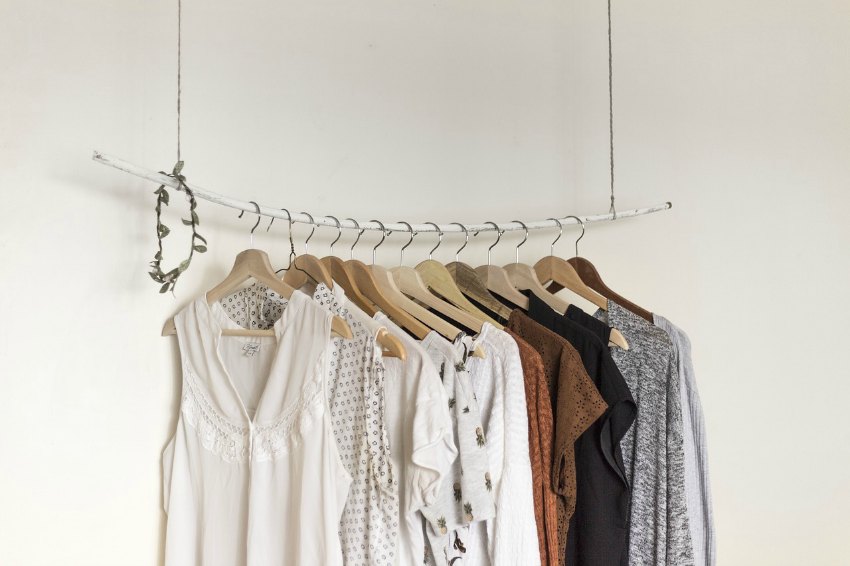How To Dry Clothes Indoors Sustainably
To support the running costs of Moral Fibres, this post contains affiliate links. This means Moral Fibres may earn a small commission, at no extra cost to readers, on items purchased through these links.
Reduce your reliance on your tumble dryer with these tips on how to dry clothes indoors sustainably. From the equipment you need, to how to avoid bad smells, and how to avoid crispy towels.
Over the years I’ve shared a lot of tips on how to do laundry sustainably. From the best eco-friendly laundry detergents to how to remove stains naturally. And recently I realised I haven’t shared my top tips on how to dry clothes indoors.
With energy bills spiralling higher and higher, it’s never been more important to curb our use of energy-intensive appliances.
The most energy-intensive appliances are ones that generate heat or need to heat up water. These include things like washing machines, dishwashers, kettles, and hairdryers. And to add to this list – tumble dryers.
While I prefer to dry my clothes outdoors, the weather doesn’t always cooperate. Instead of turning to your tumble dryer on wet days, if you are looking to reduce your reliance on tumble dryers, do try my top tips on how to dry your clothes indoors for the best results.
How To Dry Clothes Indoors Sustainably

From the correct washing technique to the equipment you need, to how to avoid bad smells, and how to avoid crispy towels, here are my top laundry drying techniques. You can use the following quick links to jump to a specific section of this post, or simply keep scrolling for the full guide:
- Start With How You Wash Your Clothes
- Use A Clothes Horse
- Try A Ceiling or Wall Mounted Clothes Airer
- Try An Electric Clothes Horse
- Open A Window
- Use A Dehumidifier
- Hang Your Clothes Properly
- How To Stop Clothes Smelling Damp
- How to Avoid Crunchy Towels
- Cut Down On The Amount of Laundry You Do
Start With How You Wash Your Clothes
As a family of four, our laundry basket is often overflowing. It can be incredibly tempting to ram as many clothes into our machine as it can possibly hold. However, I know that this is counterintuitive to having clean laundry and also the drying process.
This is because if you do that, then there is not enough space for your laundry to agitate in the machine. There will also be less water available for the detergent to dissolve in, as the clothes will soak up too much water. This means your clothes don’t come out as clean as you would like, meaning you may have to wash them again.
And what’s more, when your machine is fully packed the spin cycle is not as effective. Your clothes come out damper than they should, taking longer to dry. Particularly when it comes to drying clothes indoors, you really don’t want to start with too wet clothes.
So how much should you fill your washing machine with clothes? Aim to fill three-quarters of the drum. Anything more than that is considered overloading.
Use A Clothes Horse
Once you’ve washed your clothes, you need to consider how you dry them. When drying clothes indoors, it’s tempting to squeeze as many wet items of clothing onto your radiators, to speed up the drying process. However, drying clothes on your radiator is not particularly energy efficient.
Hanging wet clothes on your radiator makes your boiler work harder to get your room to your desired temperature. It, therefore, takes longer and uses more energy to heat your home, ultimately meaning it costs you more money.
I would always recommend using a clothes horse to dry your clothes indoors. I have a tower clothes horse (this particular Brabantia one), which takes up a small footprint – about 1 m² – but can hold up to two loads of laundry. You can even dry delicates flat, or adjust the racks for optimally drying trousers or towels.
I was given this one as part of an advertising campaign I took part in some years ago (so was under no obligation to post it here). But it goes without saying that you don’t need to buy a fancy clothes horse. If you already have one then it’s always more sustainable to use what you already have.
Try A Ceiling or Wall Mounted Clothes Airer
Standard clothes horses aren’t your only option. If you lack floor space but have the ceiling height, then one option to try would be a ceiling-mounted clothes airer. Growing up, I knew these as a pulley, but you might know them as a kitchen maid.
I had a pulley in a student flat I once lived in, and loved it. They’re really effective, as hot air rises, so your clothes dry quickly in the warmest part of the room. Ours was situated in our kitchen, so I found it best to do my laundry at night after everyone had their dinner, and then remove my dry clothes the next day. This meant that my clothes didn’t take on any food smells.
Lacking ceiling height? You can also buy wall-mounted drying racks if you lack the ceiling height but have wall space.
Try An Electric Clothes Horse
Meanwhile, some people swear by using an electric clothes horse to dry their clothes indoors. From what I have read, they are very energy efficient, and much cheaper to run than a tumble dryer. I haven’t tried one, so can’t report on their effectiveness. However, I have heard of electric clothes horses that come with tents that you pop over them to help speed up the drying process. I will report back if I ever take the plunge!
Open A Window
When drying your clothes indoors, the key thing to remember is ventilation. Damp laundry can contain up to three litres of water, which needs to evaporate.
Inadequate ventilation can cause condensation on your walls and windows when you dry your laundry. If this condensation isn’t vented out, then it can cause damp and mould growth in your home. This dampness and mould can negatively affect your health, so it is best to avoid it.
An easy way to avoid condensation is to close the door and open up a window in the room in which you are drying your laundry. Allowing fresh air to circulate whilst your laundry dries really helps to reduce moisture levels, meaning the risk of dampness and mould in your home is significantly reduced.
To add to this, I would avoid drying your laundry in your bedroom and the living room if possible. If you can, use your hallway, bathroom, or kitchen to limit potential allergic reactions to dampness, dust, and detergent.
If it’s too cold, wet, or windy to open your window for an extended period, then don’t worry. There are other workarounds. If you can dry laundry in your kitchen or bathroom, then running the extractor fan, if you have one, will also help. The extractor fan uses very little electricity so won’t drive up your bills, like a tumble drier would.
Use A Dehumidifier

We live in an old property, which wasn’t designed to cope with the levels of condensation that modern living generates. We, therefore, bought a dehumidifier, which sucks excess moisture from the air. It doesn’t run all the time, just at times when we are struggling with excess condensation.
What I’ve found is that if you pop your clothes horse in a small room, you can run the dehumidifier and not only does it tackle condensation, but it helps clothes to dry faster too. It’s nowhere near as energy-intensive as the tumble dryer, so doesn’t cost much to run either. I love our dehumidifier and wouldn’t be without it!
Hang Your Clothes Properly
It might sound obvious, but taking care to ensure that you hang your clothes neatly – pulling trousers, sleeves and socks straight – really speeds up the drying process. Adequately spacing your clothes helps too.
How To Stop Clothes Smelling Damp
Clothes start to smell damp when they take too long to dry. Adequately ventilating the room you are drying your clothes in, by opening a window, can help. Running a dehumidifier can also help, by removing moisture from your clothes, without the high running costs associated with tumble driers.
My other top tip is to spin your clothes at the maximum spin cycle your washing machine allows. Some washing cycles don’t spin on the maximum spin cycle, so a final spin cycle on the maximum setting removes any excess moisture. This makes it quicker to dry your clothes, meaning they are less likely to smell musty.
How to Avoid Crunchy Towels
Crunchy towels can be an issue when you dry your laundry indoors. If you want to keep your towels soft, then a short 10 to 15-minute cool blast in your tumble dryer when they are almost air-dried will prevent any crunchiness, without having to run your tumble dryer for a long period.
Another top tip is to reduce the amount of laundry detergent you use when washing your towels. Too much detergent can make towels feel crunchy. Halving the amount of detergent you would normally use in your washing machine helps prevent this problem. As does making your own fabric conditioner, which helps remove any excess detergent from your towels.
Cut Down On The Amount of Laundry You Do
Finally, my very best advice to help you is to simply cut down on the amount of laundry you do. The majority of us do wash our clothes too frequently. Here’s a rough guide as to how often you should wash your clothes, and here are some handy hints to freshen up your clothes without washing them.
Final Thoughts
Ditching your tumble dryer and drying your clothes indoors on wet days can save you a heap of energy and money. However, it’s important to bear in mind some simple tips to help avoid negatively impacting your health. Maintaining ventilation is key – either by opening a window or by mechanical means. Meanwhile, reducing the amount of laundry you do and how you do it can also help minimise energy usage and potential dampness.
Found this post useful? Please consider buying me a virtual coffee to help support the site’s running costs.




